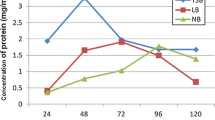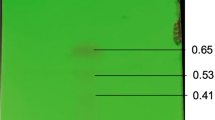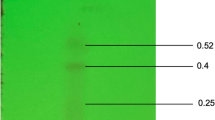Abstract
The cell-free culture filtrate of Bacillus cereus associated with an entomopathogenic nematode, Rhabditis (Oscheius) sp., exhibited strong antimicrobial activity. The ethyl acetate extract of the bacterial culture filtrate was purified by silica gel column chromatography to obtain six bioactive compounds. The structure and absolute stereochemistry of these compounds were determined based on extensive spectroscopic analyses (LCMS, FABMS, 1H NMR, 13C NMR, 1H −1H COSY, 1H −13C HMBC) and Marfey’s method. The compounds were identified as cyclo(D-Pro-D-Leu), cyclo(L-Pro-D-Met), cyclo (L-Pro-D-Phe), cyclo (L-Pro-L-Val), 3,5-dihydroxy-4-ethyl-trans-stilbene, and 3,5-dihydroxy-4-isopropylstilbene, respectively. Compounds recorded antibacterial activity against all four tested bacteria strains of Bacillus subtilis, Staphylococcus aureus, Escherichia coli, and Pseudomonas aeruginosa. 3,5-dihydroxy-4-isopropylstilbene recorded activity only against Gram-positive bacteria while cyclo(L-Pro-L-Val) recorded no antibacterial activity. Best antibacterial activity was recorded by 3,5-dihydroxy-4-ethyl-trans-stilbene (4 μg/ml) against Escherichia coli. The six compounds recorded significant antifungal activities against five fungal strains tested (Aspergillus flavus, Candida albicans, Fusarium oxysporum, Rhizoctonia solani and Penicillium expansum) and they were more effective than bavistin, the standard fungicide. The activity of cyclo(D-Pro-D-Leu), cyclo(L-Pro-D-Met), 3,5-dihydroxy-4-ethyl-trans-stilbene, and 3,5-dihydroxy-4-isopropylstilbene against Candida albicans was better than amphotericin B. To the best of our knowledge, this is the first report of antifungal activity of the bioactive compounds against the plant pathogenic fungi Fusarium oxysporum, Rhizoctonia solani, and Penicillium expansum. We conclude that the Bacillus cereus strain associated with entomopathogenic nematode is a promising source of natural bioactive secondary metabolites which may receive great benefit as potential sources of new drugs in the agricultural and pharmacological industry.


Similar content being viewed by others
References
Akhurst RJ (1982) Antibiotic activity of Xenorhabdus spp., bacteria symbiotically associated with insect pathogenic nematodes of the families Hettrorhabditidae and Steinernematidae. J Gen Microbiol 128:3061–3065
Anteunis MJO (1978) The cyclic dipeptides: proper model compounds in peptide research. Bull Chem Soc Belg 87:627–650
Bavykin SG, Lysov YP, Zakhariev V, Kelly JJ, Jackman J, Stahl DA, Cherni A (2004) Use of 16S rRNA, 23S rRNA, and gyrB gene sequence analysis to determine phylogenetic relationships of Bacillus cereus group microorganisms. J Clin Microbiol 42:3711–3730
Boszormeny E, Rsek TE, Fodor A, Fodor AM, Szldes FL, Hevesi M, Hogan JS, Katona Z, Klein MG, Kormány A, Pekár S, Szentirmai A, Sztaricskai F, Taylor RAJ (2009) Isolation and activity of Xenorhabdus antimicrobial compounds against the plant pathogens Erwinia amylovora and Phytophthora nicotianae. J Appl Microbiol 107:746–759
Chen G, Dunphy GB, Webster JM (1994) Antifungal activity of two Xenorhabdus species and Photorhabdus luminescens, bacteria associated with the nematodes Steinernema species and Heterorhabditis megidis. Biol Control 4:157–162
Chen G, Maxwell P, Dunphy GB, Webster JM (1996) Culture conditions for Xenorhabdus and Photorhabdus symbionts of entomopathogenic nematodes. Nematologica 42:124–127
CLSI, Clinical and Laboratory Standards Institute (2006) Methods for dilution antimicrobial susceptibility tests for bacteria that grow aerobically. CLSI documents M27-S3. 940 West Valley Road, Suite 1400, Wayne, Pennsylvania 19087–1898 USA
CLSI, Clinical and Laboratory Standards Institute (2008) Reference methods for broth dilution antifungal susceptibility tests of yeasts. CLSI documents M27-S3. 940 West Valley Road, Suite 1400, Wayne, Pennsylvania 19087–1898 USA
Dal Bello F, Clarke CI, Ryan LAM, Ulmer H, Schober TJ, Ström K, Sjögren J, van Sinderen D, Schnürer J, Arendt EK (2007) Improvement of the quality and shelf life of wheat bread by fermentation with the antifungal strain Lactobacillus plantarum FST 1.7. J Cereal Sci 45:309–318
De Rosa S, Mitova M, Tommonaro G (2003) Marine bacteria associated with sponge as source of cyclic peptides. Biomol Eng 20:311–316
Deepa I, Mohandas C, Makesh KT, Siji JV, Prakash KBS, Babu B (2010) Identification of new entomopathogenic nematodes (EPNs) based on sequences of D2-D3 expansion fragments of the 28SrRNA. J Root Crops 36(2):227–232
Degrassi G, Aguilar C, Bosco M, Zahariev S, Pongor S, Venturi V (2002) Plant growth-promoting Pseudomonas putida WCS358 produces and secrets four cyclic dipeptides: cross-talk with quorum sensing bacterial sensors. Curr Microbiol 45:250–254
Fdhila F, Vazquez V, Sanchez JL, Riguera R (2003) DD-Diketopiperazines: antibiotics active against Vibrio anguillarum isolated from marine bacteria associated with cultures of Pecten maximus. J Nat Prod 66:1299–1301
Forst S, Nealson KH (1996) Molecular biology of the symbiotic–pathogenic bacteria Xenorhabdus spp. and Photorhabdus spp. Microbiol Rev 60:21–43
Forst S, Dowds B, Boemare N, Stackebrandt E (1997) Xenorhabdus and Photorhabdus spp. Bugs that kill bugs. Annu Rev Microbiol 51:47–72
Gaugler R, Kaya HK (1990) Entomopathogenic nematodes in biological control. CRC, Boca Raton, pp 75–90
Graz M, Hunt A, Jamie H, Grant G, Milne P (1999) Antimicrobial activity of selected cyclic dipeptides. Pharmazie 54:772–775
Gualtieri M, Aumelasm A, Thaler JO (2009) Identification of a new antimicrobial lysine-rich cyclolipopeptide family from Xenorhabdus nematophila. J Antibiot 62:295–302
Guo Q, Guo D, Zhao B, Xu J, Li R (2007) Two cyclic dipeptides from Pseudomonas fluorescens GcM5-1A carried by the pine wood nematode and their toxicities to Japanese black pine suspension cells and seedlings in vitro. J Nematol 39(3):243–247
Holden MTG, Chhabra SR, de Nys R, Stead P, Bainton NJ, Hill PJ, Manefield M, Kumar N, Labatte M, England D, Rice S, Givskov M, Salmond GPC, Stewart GSAB, Bycroft BW, Kjelleberg SA, Williams P (1999) Quorem- sensing cross talk: isolation and chemical characterization of cyclic dipeptides from Pseudomonas aeruginosa and other gram negative bacteria. Mol Microbiol 33:1254
Houston DR, Synstad B, Eijsink VG, Stark MJ, Eggleston IM, van Aalten DM (2004) Structure-based exploration of cyclic dipeptide chitinase inhibitors. J Med Chem 47:5713–5720
Hsieh PW, Hsu LC, Lai CH, Wu CC, Hwang TL, Lin YK, Wu YC (2009) Evaluation of the bioactivities of extracts of endophytes isolated from Taiwanese herbal plants. World J Microbiol Biotechnol 25:1461–1469
Hu K, Li J, Wang W, Wu H, Lin H, Webster JM (1998) Comparison of metabolites produced in vitro and in vivo by Photorhabdus luminescens, a bacterial symbiont of the entomopathogenic nematode Heterorhabditis megidis. Can J Microbiol 44:1072–1077
Jayatilake GS, Thornton MP, Leonard AC, Grimwade JE, Baker BJ (1996) Metabolites from an antarctic sponge-associated bacterium, Pseudomonas aeruginosa. J Nat Prod 59:293–296
Ji DJ, Yi YK, Kang GH (2004) Identification of an antibacterial compound, benzylideneacetone, from Xenorhabdus nematophila against major plant-pathogenic bacteria. FEMS Microbiol Lett 239:241–248
Joyce SA, Brachmann AO, Itamar G, Lea L, Gertrud S, David C, Bode HB (2008) Bacterial biosynthesis of a multipotent stilbene. Angew Chem Int Ed 47:1942–1945
Lang G, Kalvelage T, Peters A, Wiese J, Imhoff JF (2008) Peptides from the entomopathogenic bacterium Xenorhabdus nematophilus. J Nat Prod 71:1074–1077
Li J, Chen GH, Wu HM, Webster JM (1995) Identification of two pigments and a hydroxystilbene antibiotic from Photorhabdus luminescens. Appl Environ Microbiol 61:4329–4333
Li JX, Chen GH, Webster JM (1997) Nematophin, a novel antimicrobial substance produced by Xenorhabdus nematophilus (Enterobactereaceae). Can J Microbiol 43:770–773
Li X, Sergey D, Ying X, Xiao X, Oi H, Qian P (2006) Antifouling diketopiperazines produced by a deep-sea bacterium. Streptomyces fungicidicus. Biofouling 22:201
Marfey P (1984) Determination of D-amino acids. II. Use of a bifunctional reagents, 1,5-difluoro-2,4-dinitrobenzene. Carlsberg Res Commun 49:591–596
Martins MB, Carvalho I (2007) Diketopiperazines: biological activity and synthesis. Tetrahedron 63:9923–9932
McInerney BV, Gregson RP, Lacey MJ, Akhurst RJ, Lyons GR, Rhodes SH, Smith DRJ, Engelhardt LM (1991a) Biologically active metabolites from Xenorhabdus spp. Part 1. Dithiolopyrrolone derivatives with antibiotic activity. J Nat Prod 54:774–784
McInerney BV, Taylor WC, Lacey MJ, Akhurst RJ, Gregson RP (1991b) Biologically active metabolites from Xenorhabdus spp. Part 2 Benzopyran-1-one derivatives with gastroprotective activity. J Nat Prod 54:785–795
Mohandas C, Sheeba M, Firoza AJ, Rajamma P (2007) Bacteria associated with Rhabditis (Oscheius) spp. (Rhabditidae: Nematoda) for the biocontrol of insect pests. Proc Nat Seminar on Achievements and Opportunities in Post harvest Management and Value Addition in Root and Tuber Crops (NSRTC–2), p 195–198
Murray PR, Baron EJ, Pfaller MA, Tenover FC, Yolke RH (1995) Manual clinic microbiol, vol 6. ASM, Washington, DC
Nicholson B, Lloyd GK, Miller BR, Palladino MA, Kiso Y, Hayashi Y, Neuteboom ST (2006) NPI-2358 is a tubulin-depolymerizing agent: in-vitro evidence for activity as a tumor vascular-disrupting agent. Anticancer Drugs 17:25–31
Paul VJ, Frautschy S, Fenical W, Nealson KH (1981) Antibiotics in microbial ecology, isolation and structure assignment of several new antibacterial compounds from the insect symbiotic bacteria Xenorhabdus spp. J Chem Ecol 7:589–597
Prasad C (1995) Bioactive cyclic dipeptides. Peptides 16:151–164
Rhee KH (2002) Isolation and characterization of Streptomyces sp. KH-614 producing anti-VRE (vancomycin-resistant enterococci) antibiotics. J Gen Appl Microbiol 48:327–331
Rhee KH (2003) Purification and identification of an antifungal agent from Streptomyces sp. KH-614 antagonistic to rice blast fungus, Pyricularia oryzae. J Microbiol Biotechnol 13(6):984–988
Rhee KH (2004) Cyclic dipeptides exhibit synergistic, broad spectrum antimicrobial effects and have anti-mutagenic properties. Int J Antimicrob Agents 24:423–427
Rhee KH (2006) In vitro activity of cyclic dipeptides against gram-positive and gram- negative anaerobic bacteria and radioprotective effect on lung cells. J Microbiol Biotechnol 16(1):158–162
Richardson WH, Schmidt TM, Nealson KH (1988) Identification of an anthraquinone pigment and a hydroxystilbene antibiotic from Xenorhabdus luminescens. Appl Environ Microbiol 54:1602–1605
Rollas S, Kalyoncuoglu N, Sur-Altiner D, Yegenglu Y (1993) 5-(4-Aminophenyl)-4-substituted 2,4-dihydro-3H-1,2,4-triazole-3-thiones: synthesis, antibacterial and antifungal activities. Pharmazie 48:308–309
Rudi A, Kashman Y, Benayahu Y, Schleyer M (1994) Amino acid derivatives from the marine sponge Jaspis digonoxea. J Nat Prod 57:829
Saitou N, Nei M (1987) The neighbor-joining method: a new method for reconstructing phylogenetic trees. Mol Biol Evol 4:406–425
Shin HJ, Mojid Mondol MA, Yu TK, Lee HS, Lee YJ, Jin HJ, Kim JH, Kwon HJ (2010) An angiogenesis inhibitor isolated from a marine-derived actinomycete, Nocardiopsis sp. 03N67. Phytochem Lett 3:194–197
Smith-Palmer A, Stewart J, Fyfe L (1998) Antimicrobial properties of plant essential oils and essences against five important food-borne pathogens. Lett Appl Microbiol 26:118–122
Song MK, Hwang IK, Rosenthal MJ, Harris DM, Yamaguchi DT, Yip I, Go VLW (2003) Anti-hyperglycemic activity of zinc plus cyclo(His-Pro) in genetically diabetic goto-kakizaki and aged rats. Exp Biol Med 228:1338–1345
Stierle AC, Cardellina JH, Strobel GA (1988) Maculosin, a host-specific phytotoxin for spotted knapweed from Alternaria alternate. Proc Natl Acad Sci USA 85(21):8008–8011
Strom K, Sjogren J, Broberg A, Schnurer J (2002) Lactobacillus plantarum MiLAB 393 produces the antifungal cyclic dipeptides cyclo(L-Phe-L-Pro) and cyclo(L-Phe-trans-4-OH-L-pro) and 3-phenyllactic acid. Appl Environ Microbiol 68:4322–4327
Tailliez P, Laroui C, Ginibre N, Paule A, Page S, Boemare N (2010) Phylogeny of Photorhabdus and Xenorhabdus based on universally conserved protein-coding sequences and implications for the taxonomy of these two genera. Proposal of new taxa: X. vietnamensis sp. nov., P. luminescens subsp. Caribbeanensis subsp. nov., P. luminescens subsp. hainanensis subsp. nov., P. temperata subsp. Khanii subsp. nov., P. temperata subsp. Tasmaniensis subsp. nov., and the reclassification of P. luminescens subsp. thracensis as P. temperate subsp. thracensis comb. nov. Syst Evol Microbiol 60:1921–1937
Tamura K, Peterson D, Peterson N, Stecher G, Nei M, Kumar S (2011) MEGA5: molecular evolutionary genetics analysis using maximum likelihood, evolutionary distance, and maximum parsimony methods. Mol Biol Evol 28(10):2731–2739
Thompson JD, Higgins DG, Gibson TJ (1994) Clustal-W—Improving the sensitivity of progressive multiple sequence alignment through sequence weighting, position-specific gap penalties and weight matrix choice. Nucleic Acids Res 22:4673–4680
van der Merwe E, Huang D, Peterson D, Kilian G, Milne PJ, Van de Venter M, Frost C (2008) The synthesis and anticancer activity of selected diketopiperazines. Peptides 29:1305–1311
Wang Y, Mueller UG, Clardy J (1999) Antifungal diketopiperazines from symbiotic fungus of fungus-growing ant Cyphomyrmex minutus Antifungal. J Chem Ecol 25(4):245–257
Wang G, Dai S, Chen M, Wu H, Lianwu X, Xiongming L, Li Z (2010) Two diketopiperazine Cyclo(Pro-Phe) isomers from marine bacteria Bacillus subtilis sp. 13-2. Chem Nat Comps 46(4):583–585
Yan PS, Song Y, Sakuno E, Nakajima H, Nakagawa H, Yabe K (2004) Cyclo(Lleucyl-L-prolyl) produced by Achromobacter xylosoxidans inhibits aflatoxin production by Aspergillus parasiticus. Appl Environ Microbiol 70:7466–7473
Yang L, Tan R, Wang Q, Huang W, Yinc Y (2002) Antifungal cyclopeptides from Halobacillus litoralis YS3106 of marine origin. Tetrahedron Letts 43:6545–6548
Acknowledgments
The authors are grateful to the Indian Council Medical Research (ICMR), Government of India for funding. We thank the Director, CTCRI, for providing facilities for the work.
Author information
Authors and Affiliations
Corresponding author
Electronic supplementary material
Below is the link to the electronic supplementary material.
ESM 1
(DOCX 16 kb)
Rights and permissions
About this article
Cite this article
Kumar, S.N., Nambisan, B., Sundaresan, A. et al. Isolation and identification of antimicrobial secondary metabolites from Bacillus cereus associated with a rhabditid entomopathogenic nematode. Ann Microbiol 64, 209–218 (2014). https://doi.org/10.1007/s13213-013-0653-6
Received:
Accepted:
Published:
Issue Date:
DOI: https://doi.org/10.1007/s13213-013-0653-6




